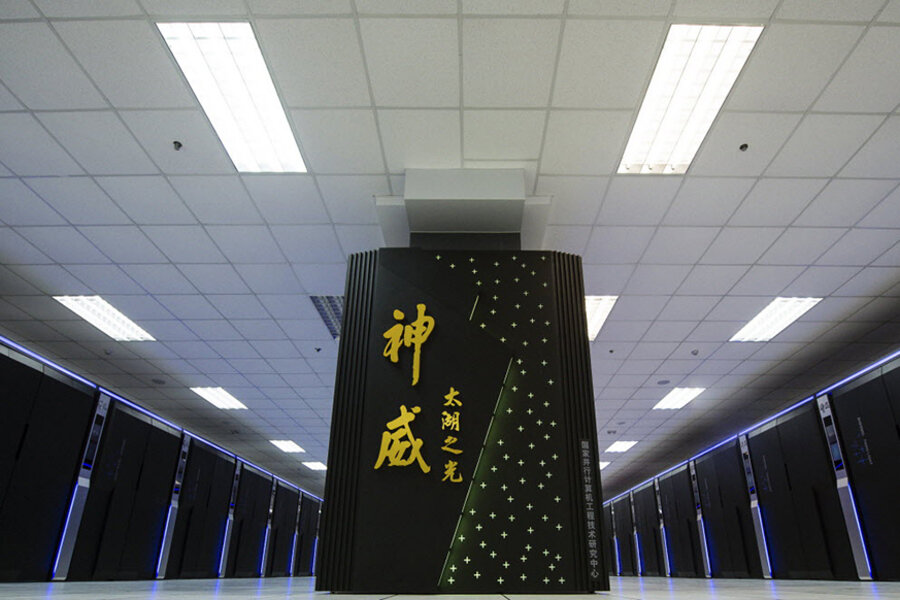How China built world's fastest computer without US chips
Loading...
China has built the world's fastest supercomputer, capable of making 93 quadrillion calculations a second. And for the first time, it's entirely powered by Chinese-made processors, following a US ban on exporting chips for devices suspected to be used for nuclear research.
The Sunway TaihuLight supercomputer, which is located at the state-funded Chinese Supercomputing Center in Wuxi, a city near Shanghai in eastern China, is more than twice as powerful as previous record-holder Tianhe-2, according to TOP500, a research organization that ranks the powerful computers twice a year.
The milestone comes a year after the United States barred exports of computer chips to China for use in its supercomputers, citing concerns that the machines had been used in "nuclear explosive activities." In turn, by ramping up development of its own chips, China has come to surpass the US' own achievements in supercomputing: the top-placing American creation, the Department of Energy's Titan, secured third place ranking on TOP500's list, below China's two-record breaking supercomputers.
"It's not based on an existing architecture. They built it themselves," Jack Dongarra, a professor at the University of Tennessee, who created the measurement method used by TOP500, told Bloomberg of the top-placed Chinese computer. "This is a system that has Chinese processors."
In both the US and China, supercomputers are highly prized for their ability to make complex calculations that are used in nuclear simulations and for civilian scientific research, such as an effort by the US Department of Energy to analyze billions of gigabytes of "big data."
The room-sized computers use thousands of chips linked together by servers rather than a central processor. But China's TaihuLight, which has some 41,000 chips that each contain 260 processor cores, also uses a relatively small amount of memory – 1.3 petabytes – which helps improve its energy efficiency, The Verge reports.
It draws only 15.3 megawatts of power, less than the the 17.8 megawatts used by China's Tianhe-2, the previous record holder, which could make 33 quadrillion calculations (also known as petaflops) a second.
The US' fastest supercomputer, by contrast, has a top speed of about 17,590 petaflops, making China's machine roughly five times as fast. Its Titan supercomputer, located at the Oak Ridge National Laboratory in Tennessee, is being used for a variety of scientific research, including climate modeling, the lab says.
The supercomputers are used in both defense research and cybersecurity and for civilian applications. China says it plans to use the TaihuLight in manufacturing, life science, and earth systems modeling, The Verge reports.
But in April 2015, the US Commerce Department said that the earlier Tianhe-2 and its predecessor that were powered by Intel chips "are believed to be used in nuclear explosive activities," prompting the ban on foreign exports. The designers of the Tianhe-2, however, said the supercomputer was mostly used for civilian research.
The decision put some chipmakers that had been providing chips to China, including Intel, in a bind. Many were already grappling with new rules from Beijing, such as a new counterterrorism law, which they said were too invasive, as The Wall Street Journal reported.
Similar debates about how the technology could be used have also surfaced in the US. Last year, a group of prominent researchers and entrepreneurs, including Tesla head Elon Musk, physicist Stephen Hawking, and linguist Noam Chomsky, penned an open letter warning that advanced computing and artificially intelligence technology in the US could be used as weapons of war.
Details of exactly how the supercomputers are used are sometimes vague. But researchers in the US appear to be using a supercomputing system that uses deep learning – the human-brain inspired machine learning technology that Google uses to power its Go champion computer and other systems – for nuclear research.
That system, located at the Lawrence Livermore National Laboratory in California, is being used for "control of US nuclear weapons, and, in theory, management of agreements to reduce the number of nuclear missiles in the world," ZDNet reported in March.
The chip ban doesn't appear to have deterred China from continuing its rapid progress in developing supercomputers. While it had no entries in TOP500's list in 2001, it now has 167 entries compared to the US' 165, Dr. Dongarra told Bloomberg.
"This is the first time that the Chinese have more systems than the U.S., so that, I think, is a striking accomplishment," he said.





